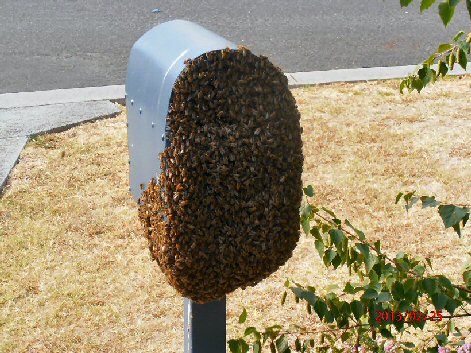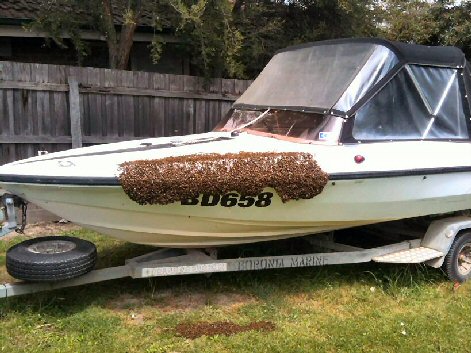Bee Swarms
Swarms of European Honeybees
Swarming is a fundamental part of the natural reproductive life cycle of honeybees. One bee colony reproduces by splitting up in two or sometimes more. Swarming usually occurs from spring to early summer, i.e. between September and December here in Victoria.
Swarms usually emerge from their colonies on warm, sunny days. Prior to the swarming event the colony has started to raise several successor queens due to hatch from their cells. Before the new queens are emerging from their cells the swarm with the old queen has to leave the hive. There is a one week window of opportunity for selecting a warm and sunny day for swarming. When this window closes the swarm has to leave regardless of the weather, even hail and cold winds won't stop it.
Such a natural spectacle begins with thousands of flying bees emerging from their hive and buzzing around and above it. About ten minutes later this buzzing cloud slowly drifts away for only a few meters or a few hundred meters, just to gather again, in form of a swarm cluster, often hanging on a tree branch, all clinging to each other.
What to do when a swarm of bees arrives on your property
When a swarm of bees arrives on your property there is no need to panic!
Despite the thousands of bees buzzing around, they are not on the attack.
Consider yourself as fortunate being able to witness one of nature's wonderful performances. All the bees are doing is looking for a new home. The bees enjoy their time outside, full of joy and excitement, to sting is not on their mind at all.
However, if the swarm has been interfered with prior to the arrival on your property, the bees might be agitated and not so joyful anymore.
When you see a swarm of honeybees settling on your property:
- Keep children and pets inside the house until the flying bees have clustered onto a bush or another object.
- After the swarm has clustered and most of the bees have stopped flying, it is usually safe to be outside the house.
- Keep children and animals well away from the swarm.
- Arrange to have the swarm removed by a beekeeper.
- Wear footwear to protect your feet in case bees have settled or are crawling on the ground.
- Do not attempt to move the swarm by hosing it, throwing stones at it, smoking the bees or taking any action to make the swarm move.
- Do not spray the swarm with fly spray or any other pesticide.
- Any interference with the swarm will only aggravate the bees and encourage them to sting in defence.
- Interfering with the swarm will make it more difficult for a beekeeper to deal with the bees.
Will the swarm move on?
Yes, in most cases !
From the location of the swarm cluster a few scout bees try to locate a new home, while some other bees continue their normal foraging activities.
In most cases the search for a new home is successfully completed within a few hours or days, upon which the swarm cluster leaves as a drifting buzzing cloud, relocating to their new home.
If the swarm cluster stays at its location for longer than a few days, usually when unable to search and find a new home due to cold/rainy weather, the bees start building comb, attaching it to the structure they are hanging on. They then start storing the newly gathered nectar and pollen whilst continuing to extend the comb. After another few days the queen starts laying eggs. Within one to two weeks, the swarm cluster location, initially chosen as temporary camp, has become their permanent brood nest.
European Honeybees do normally build their nest in sheltered, darkened cavities, protected from the elements. However, probably due to the mild weather conditions here in Australia or forcing circumstances the bees sometimes build their nest out in the open.
When you need a Swarm removed
Bee Swarm Photos
Bee Swarm on maple tree
Tiny Bee Swarm
Small Bee Swarm on letter box

Was this huge swarm preparing for a fishing trip?
